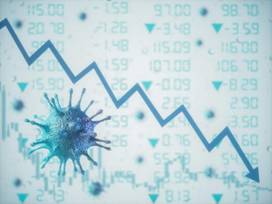The second wave has arrived. Every day, more evidence emerges that the second wave is no longer confined to Maharashtra. It’s no longer just a wave, but a possible tsunami, with the daily run rate of cases surpassing the first-wave peak. The second COVID-19 wave comes at a time when India’s economy has made a resilient comeback.

The previous fiscal year (2020-21) began with the nation being put under one of the strictest lockdowns in the world. Few would have predicted that April 2021 would be worse than April 2020 in terms of Covid cases at the time. Indeed, initial government figures from last year indicated that no new Covid cases will be filed after May 16, 2020.Covid instances, on the other hand, have shown a “V-shaped” recovery. At the time of the last count, India had 1.75 times the number of regular cases as it did in September 2020.
What’s worse is, despite a year of knowledge about the critical need to adopt Covid-appropriate behaviour and the availability of numerous Covid vaccines, this new surge is happening. The government’s mismanagement of the vaccination campaign, which resulted in various locations declaring shortages, as well as the people’s willful disregard for upholding social distancing norms, both contribute to the current surge.
The second wave could not have come at a worse time for India. Corporate hiring plans have been disrupted, market uncertainty has risen, and operations have been crippled. All of these factors have the potential to exacerbate problems for India’s working class, particularly low-wage earners and migrant workers.The Reserve Bank of India (RBI) has conducted two recent surveys that indicate the economic situation may deteriorate as a result of new restrictions imposed to control the rapid increase in Covid-19 cases.
According to survey consumer confidence for the current period weakened in March 2021 as the current situation index dipped further in the negative territory on the back of deteriorating sentiments on the general economic situation, income and prices. Consumer confidence, according to experts, is a crucial component of economic recovery, and any lag could have a direct impact on how people spend. Lower investment may have a direct effect on the demand curve, affecting business operations and the economy’s recovery.
With Covid-19 restrictions being expanded and lockdown measures being re-introduced in several states, Indian manufacturers are in for a difficult month in April.Some service-oriented businesses in the transport, tourism, and hospitality industries have been caught off guard by the restrictions. This will have a significant effect on the economies of the country’s tourism-dependent states.It should be noted that the travel and tourism industry accounts for nearly 7% of India’s GDP. The total sector added $194 billion to the country’s GDP in 2019. Although the sector hoped to rebound in FY22, the country’s rising Covid-19 trajectory appears to have thwarted recovery plans.
During the first wave of the pandemic, restaurants, hotels, and other similar businesses suffered the greatest losses and have only recently recovered. Many of these companies could be doomed by the fresh curbs. As a result, millions of employees and staff will lose their jobs or see their pay cut yet again. Given that neither banks nor the government would be able to match the relief measures announced last year during the first wave, the economic damage may be devastating. The first wave of Covid-19 wreaked havoc on India’s economy, but the shock was mitigated to a large extent by government and Reserve Bank of India relief measures.

Under the Aatmanirbhar Bharat package, the government announced a series of relief measures aimed at limiting economic harm. In addition, the Reserve Bank of India announced a slew of initiatives aimed at protecting individuals and businesses from the crisis. One such measure was the extension of a loan moratorium to borrowers.However, the relief steps might not be as extensive this time. Despite last year’s generous efforts, government revenues are now stretched, and banks are in a much poorer position to support borrowers.

As a result, if the second wave worsens, relief measures will not be enough to keep the economy afloat. Additional borrowing may be the government’s only option, but it will come at the expense of stretching the fiscal deficit further.It is impossible to sum up the situation in India without mentioning that it is critical at the moment, both in terms of healthcare and economic resilience. For the second time in less than two years, the increasing daily caseload may result in stricter curbs across many states, and companies may not be able to endure the same amount of pressure.
Since India’s economy lost a huge portion of its immunity to the virus in the first wave, the risk is much higher this time. Surviving a more lethal second wave would be impossible if it lasts for an extended period of time. The industry has developed resilience in the face of one of the most difficult years in decades, but new restrictions introduced by states in the wake of rising Covid cases are bound to test them again. Much now depends on how the Covid outbreak can be dealt with in accordance with safety precautions and an ambitious vaccination campaign, so that the economy, which is on the fragile road to recovery, does not suffer another setback.
Written by- Shivangi Goel
IMAGE SOURCES
